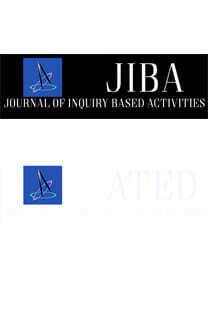LET’S FORM A REFLEX ARC MODEL: A STEM ACTIVITY
REFLEKS YAYI MODELİ OLUŞTURALIM: BİR STEM ETKİNLİĞİ
___
Abayhan, B. (2013, February 7). Klasik koşullanma [Classical conditioning] [Video file]. Retrieved from youtube.com/watch?v=3r6lqNj5FhYAkgündüz, D., Aydeniz, M., Çakmakçı, G., Çavaş, B., Çorlu, M. S., Öner, T., & Özdemir, S. (2015). A report on STEM education in Turkey: A provisional agenda or a necessity? İstanbul: İstanbul Aydın University STEM Center and Education Faculty.
Aydın-Günbatar, S. (2018). Designing a process to prevent apple’s browning: A STEM activity. Journal of Inquiry Based Activities, 8(2), 99-110. Retrieved from http://www.ated.info.tr/index.php/ated/issue/view/16
Boddy, N., Watson, K., & Aubusson, P. (2003). A Trial of the five Es: A referent model for constructivist teaching and learning. Research in Science Education, 33, 27–42.
Bybee, R. W. (1997). Achieveing scientific literacy: From purpose to practices. Portsmouth, UK: Heinemann.
Bybee, R. W. (2010). Advancing STEM education: A 2020 vision. Technology and Engineering Teacher, 70, 30-35.
Bybee, R. W., Taylor, J. A., Gardner, A., Scotter, P. V., Powell, J. C., Westbrook, A., & Landers, A. (2006). The BSCS 5E instructional model: Origins and effectiveness. Colorado Springs, CO: Biological Sciences Curriculum Study. Retrieved from http://www.fremonths.org/ourpages/auto/2008/5/11/1210522036057/bscs5efullreport2006.pdf
Chute, E. (2009, February 10). STEM education is branching out. Pittsburgh Post-Gazette. Retrieved from http://www.post-gazette.com/news/education/2009/02/10/STEM-education-is-branching-out/stories/200902100165
Corlu, M. S., Capraro, R. M., & Capraro, M. M. (2014). Introducing STEM education: Implications for educating our teachers for the age of innovation. Education and Science, 39(171), 74-85.
Çepni, S., & Ormancı, Ü. (2018). Geleceğin dünyası [The future world]. In Çepni, S. (Ed.), Kuramdan uygulamaya STEM eğitimi [STEM education from theory to practice] (1-37). Ankara: Pegem Academy.
Gokbayrak, S., & Karisan, D. (2017). An investigation of the effects of STEM based activities on preservice science teacher’s science process skills. Western Anatolia Journal of Educational Sciences, 8(2), 63-84.
Gülhan, F. (2016). Fen-teknoloji-mühendislik matematik entegrasyonunun (STEM) 5. sınıf öğrencilerinin algı, tutum, kavramsal anlama ve bilimsel yaratıcılıklarına etkisi [The effects of science-technology-engineering-math integration (STEM) of 5th grade students on perceptions, attitudes, conceptual meaning and scientific creativities] (Unpublished dissertation). Marmara Üniversitesi Eğitim Bilimleri Enstitüsü, İstanbul.
Karplus, R., & Thier, H. (1967). A new look at elementary school science. Chicago: Rand McNally.
Ministry of National Education. (2013). Ortaöğretim biyoloji dersi öğretim programı (9-12. sınıflar) [Biology curriculum (9-12. grades)]. Ankara: Talim ve Terbiye Kurulu Başkanlığı.
Ministry of National Education. (2018). Ortaöğretim biyoloji dersi öğretim programı (9-12. sınıflar) [Biology curriculum (9-12. grades)]. Ankara: Talim ve Terbiye Kurulu Başkanlığı.
Moore, T. J., Stohlmann, M. S., Wang, H. H., Tank, K. M., Glancy, A. W., & Roehrig, G. H. (2014). Implementation and integration of engineering in K-12 STEM education. In S. Purzer, J. Strobel, & M. Cardella (Eds.), Engineering in precollege settings: Research into practice (pp. 35-60). West Lafayette, IN: Purdue University Press.
Morrison, J. (2006). Attributes of STEM education: The student, the school, the classroom. Baltimore, MD: The Teaching Institute for Excellence in STEM.
National Research Council. (2012). A framework for K–12 science education: Practices, crosscutting concepts, and core ideas. Washington, DC: The National Academies Press.
Purves, W. K., Orians, G. H., Heller, H. C., & Sadava, D. (1997). LIFE: The science of biology (Fifth edition). Sunderland, MA: Sinauer Associates.
Roehrig, G. H., Moore, T. J., Wang, H. H., & Park, M. S. (2012). Is adding the E enough? Investigating the impact of K12 engineering standards on the implementation of STEM integration. School Science and Mathematics, 112, 31-44. Sanders, M. (2009). STEM, STEM education, STEMmania. The Technology Teacher, 68(4), 20-26.
Stohlmann, M., Moore, T. J., & Roehrig, G. H. (2012). Considerations for teaching integrated STEM education. Journal of Pre-College Engineering Education Research, 2(1), 28–34. doi: 10.5703/1288284314653.
Tonseenon, K. (2017). The effects of 5E learning cycle model on achievement and science lessons design ability of science student teachers. Paper presented at the ISER 58th International Conference, Kobe, Japan.
Yıldırım, B., & Altun, Y. (2015). Investigating the effect of STEM education and engineering applications on science laboratory lectures. El-Cezerî Journal of Science and Engineering, 2(2), 28-40.
- ISSN: 2146-5711
- Yayın Aralığı: 2
- Başlangıç: 2011
- Yayıncı: Mustafa ÇAKIR
REFLEKS YAYI MODELİ OLUŞTURALIM: BİR STEM ETKİNLİĞİ
BİLİMİN DOĞASI ÖĞRETİMİNDE BİLİM TARİHİNİN NASIL KULLANILABİLECEĞİNİ GÖSTEREN BİR ETKİNLİK
ELEMENTLER VE PERİYODİK SİSTEMİN ÖĞRENİLMESİNE İLİŞKİN ETKİNLİK ÖRNEĞİ
LET’S FORM A REFLEX ARC MODEL: A STEM ACTIVITY
ATMOSFERDEKİ SICAKLIK DEĞİŞİMİNDE ROL OYNAYAN GAZLARIN ETKİSİ: BİR STEM ETKİNLİĞİ
AN ACTIVITY SHOWING HOW TO USE HISTORY OF SCIENCE IN TEACHING NATURE OF SCIENCE
REHBERLİ ARAŞTIRMA-SORGULAMA YAKLAŞIMINA UYGUN WEB DESTEKLİ FEN MATERYALİ GELİŞTİRİLMESİ: KEMİKLER
DOĞADA TASARLANAN SORGULAMA TEMELLİ BİR BİLİM ETKİNLİĞİ: MİLLİ PARK’IN BİYOÇEŞİTLİLİĞİ TEHLİKEDE!
NAKLİYE FİRMALARI İÇİN TAŞINMA PROBLEMİ: MÜHENDİSLİK TASARIM ODAKLI ETKİNLİK ÖRNEĞİ
